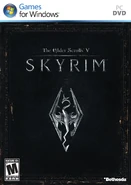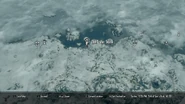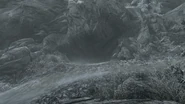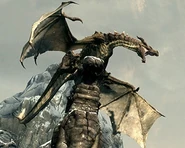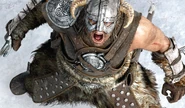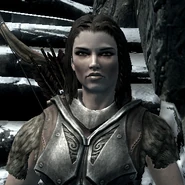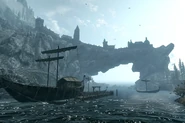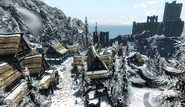Template:Eras
- For the Nords' homeland, see Skyrim.
Template:Infobox CVG The Elder Scrolls V: Skyrim is a single-player role-playing video game developed by Bethesda Game Studios and published by Bethesda Softworks. It is the fifth installment in The Elder Scrolls action/adventure RPG fantasy video game series, and follows The Elder Scrolls IV: Oblivion by approximately 200 years, during the 4th Era. The game was announced on November 11, 2010 at the Spike Video Game Awards in Topeka, with a release date of November 11, 2011. It features Radiant A.I, along with Radiant Storytelling or Radiant Story, to help enhance quests, and a new and improved graphics engine.[1][2]
Plot
Two hundred years have passed since the events of The Elder Scrolls IV: Oblivion, and it is now the 201st year of the Fourth Era (4E 201). The High King of Skyrim has been murdered, and the threat of civil war looms over the land of Skyrim; One side wishes to secede from the crumbling Empire, while the other wishes to remain a part of it, believing that it is still worth fighting for. To make matters worse, this schism is the final event in a prophecy foretold by the Elder Scrolls that will lead to the return of the dragons under Alduin, the Nordic god of destruction.
The player begins the game imprisoned by the Imperial Legion, being led to their execution as a result of crossing the border into Skyrim. As the player lays their head on the chopping block, the dragon Alduin attacks. In the midst of the chaos, several Stormcloaks, along with their leader and fellow prisoner, Ulfric Stormcloak, assist in the player's escape. The player may choose between the assistance of Ralof, the Stormcloak who arrived with Ulfric, or of Hadvar, the Imperial soldier responsible for reading off the names of the prisoners being sent to their execution. The player later learns that he/she is Dovahkiin, or Dragonborn, a person charged with the duty of defeating Alduin and the dragons. Eventually, the player meets Delphine and Esbern, two of the last remaining Blades.
Setting
The fifth installment of The Elder Scrolls takes place in Skyrim, where peace is threatened by the ongoing civil war between a Nordic separatist faction and the Empire's IV Legion, as well as the return of the dragons under the game's main antagonist, the great dragon Alduin (seemingly separate from, but religiously considered the Nordic equivalent of Akatosh).
Skyrim is the northernmost region of Tamriel and its geography consists of mountains, snowy tundras, pine forests, rural countrysides and arctic plains. Its architecture and atmosphere is very similar to the town of Bruma in The Elder Scrolls IV: Oblivion. Although it is roughly the same size as Oblivion's Cyrodiil (approximately 41 square kilometers in area or 15.8 square miles), it is the least populated of all regions in Tamriel and features more lush forests and grassy areas than Cyrodiil. Although there are only five cities within the province, most are larger than the cities of Cyrodiil and are complemented with smaller townships dotted through the land with huge swathes of wilderness separating them all.
There are over 150 dungeons scattered across Skyrim. Fast-traveling is a returning feature, allowing the player to instantly travel to any marked location that has been previously visited.
New enemies to the series include Mountain Giants, Frost Trolls, Mammoths, Frostbite Spiders, Ice Wraiths, Hagravens, and Dragons. The game will feature non-hostile dragons, but they are quite rare and usually important to the storyline. There will also be children present in the game for the first time since Daggerfall, where they made several appearances.
Other provinces of Tamriel, such as parts of High Rock and Morrowind, as well as the majority of Hammerfell and Cyrodiil are also present in the game, albeit in a barren and inaccessible state (without the use of console commands), possibly as placeholders for future expansions or downloadable content. Hints pointing to this possibility include: The presence of an impassable gate in the southeast of Riften that seemingly leads into the province of Morrowind, another gate southwest of Falkreath that would lead to Cyrodiil and a half-modeled portion of the White Gold Tower in what would be the Imperial City.
Gameplay
Skyrim retains the traditional open-world gameplay found in the Elder Scrolls series. The player is free to roam the land of Skyrim at will, either on-foot or on horseback. The player can train in eighteen different skills, and increasing the levels of these skills contributes to raising overall player level, with increases in higher-leveled skills affording a greater boost toward the next player level than increases in lower-leveled skills. The traditional RPG concept of a class system has been abolished in Skyrim; it has been supplanted with a very free-form system that allows players to use perks to specialize their skills in somewhat traditional fashion without actually locking characters into static classes. Perks are skill-specific abilities, organized in a system of branching groups called "skill trees." The player can choose from one of many perks each time their character gains a level. Player leveling extends somewhat further than in previous Elder Scrolls games, reaching a maximum level of 81 when all skills have been increased to 100; this limit is due in part to a significant sharpening of the experience curve for leveling after 50.[3]
Weapons and armor may be crafted by players at forges, and all gear may be improved upon using other crafting facilities provided that the player possesses the requisite skill levels and perks; this allows for a wide range of equipment variation and lets those characters with the highest skills outfit themselves with appropriately powerful equipment. The player can also enchant their weapons for extra damage and gain special abilities from them.
Melee combat has been overhauled from Oblivion, with weapon attacks taking a less fluid - and much more realistic - pace. Weapon types such as the previous Blade and Blunt have been condensed into One-handed and Two-handed weapon skills, with the axes, maces, and swords each benefitting differently from perks inside these skill trees; for example, axes can add extra bleeding damage, swords strike quickly and can gain a higher chance of a critical hit, and maces gain armor penetration while striking at a slower rate. Special "critical kills" have also been added, which show a slow-motion killing blow such as impalement or decapitation being delivered by the player character.
Spell mechanics have changed significantly in Skyrim as compared to Oblivion. Fire, frost, and shock spells now have useful additional effects; fire deals additional burn damage, shock does an additional 50% of its damage to the victim's Magicka, and frost spells deal 100% of their damage to the victim's Stamina. Quests have been implemented to gain Master-level spells in each school, and these spells have special casting animations and often much more powerful effects than their lesser counterparts. The school of Mysticism has been removed entirely from the magic system, with its spells being redistributed to other magic schools.
Skyrim makes use of the Radiant AI ,artificial intelligence, system created for Oblivion, which has been updated to allow NPCs to "do what they want under extra parameters." The updated system allows for greater interaction between NPCs and their environments; NPCs will now perform tasks such as mining, milling, smithing, potion-making, cooking, and other menial labors, and will continue to go about such business if the player speaks to them while they are working. Additionally, player marriage has been implemented in Skyrim; through a brief courtship process the player may marry select NPCs of either gender, offering a housemate as well as a range of spouse-exclusive benefits. The player can also have companions or followers in the game, they can be found in taverns or some stores or by gaining a title in a certain hold. When the player become the thane of a certain hold they automatically get a companion to assist them.
Skills
There are eighteen skills in all, six for each style of play (Magic, Combat and Stealth). They are as follows:
The Mage
The Warrior
The Thief
Acrobatics and Athletics have been entirely removed from the game. Fall damage scales with distances, and players may run more quickly by using the newly-implemented sprinting function both in and out of combat.
Leveling Up, Classes & Customization
The leveling mechanic in The Elder Scrolls V: Skyrim is similar to previous titles, with the player leveling up after enough skills have, themselves, been leveled up through use. Game director Todd Howard stated that the game's "mathematical" level cap is 70;[4] however, the Prima Official Game Guide states the level cap is "around 80."[5] One of the largest differences from previous Elder Scrolls games is that you no longer specify a group of major and minor skills; instead, all skills are treated the same, and all skills contribute towards leveling up.[6] As a result of this change, there is no longer any class selection component to character creation.
A significant new feature to The Elder Scrolls series is the addition of a total of 251 perks, one granted each level, which allow for further specialization. Each skill is presented as a constellation, built up of node stars representing the perk tree, within a firmament. For example, a player using one-handed weapons could specialize in maces with a perk that ignores opponents' armor, select a perk granting swords an increased chance of landing a critical hit, or prioritize axes by choosing a perk that makes enemies bleed, causing damage over time.
Character visual customization has been further refined from previous Elder Scrolls games, introducing new customization options such as pre-built beards and faces, war paint and scars, and otherwise enhanced facial construction. Body size is also now an editable feature, along with different presets for nearly all facial features.
Also new to the Elder Scrolls series are the Guardian Stones, large carved obelisks scattered throughout the game world, found singly or in a single group of 3 (near the game start area). By activating the stone of your choice, your character is granted one or more bonuses or powers; a new stone may be selected later, but only one stone can be active at a time. There are thirteen Guardian Stones, corresponding to - and replacing - the thirteen Birthsigns of previous games.
Unlike the prior Elder Scrolls games, which featured 8 attributes that could be increased through leveling, Skyrim has only three values to increase, one of which can be selected each level: Health, Magicka, or Stamina. This was done for the dual purposes of simplifying the leveling process and reducing unnecessary statistics, as the 8 attributes were considered to be simply a means of increasing the three above values.
Races
The option to choose from one of the 10 main races of Tamriel - Imperials, Nords, Redguards, Bretons, Dark Elves, High Elves, Wood Elves, Orcs, Khajiit, and the Argonians - is still available. Each race is characterized by a specific power and passive bonus, as well as starting with a few skills at slightly higher levels. For example, High Elves begin the game with 50 extra magicka, the ability to drastically increase their magicka regeneration rate for 60 seconds once per day, and five extra points in several of the magic skills.
Playable races include:
- Altmer (High Elves - Summerset Isles)
- Argonian (Reptilians, or Lizards - Black Marsh)
- Breton (Humans - High Rock)
- Bosmer (Wood Elves - Valenwood)
- Dunmer (Dark Elves - Morrowind)
- Imperial (Humans - Cyrodiil)
- Khajiit (Felines - Elsweyr)
- Nord (Humans - Skyrim)
- Redguard (Humans - Hammerfell)
- Orsimer (Orcs - Orsinium)
There are also two unplayable races which are mentioned throughout the gameplay:
- Snow Elves (Falmer) - The Snow Elves were a race that inhabitated Skyrim long before the Nords. The Elves were massacred by the Nords and fled underground. Here they found refuge with the Dwemer who eventually betrayed them and force-fed them a poisonous fungi which caused blindness. The effects of the algae morphed them into the horrible Falmer you see so often in caverns, Dwemer ruins and Falmer Hives.
- Dwarves (Dwemer) - A long lost race that once lived throughout Vvardenfell, Skyrim and Hammerfell . They prefered the use of technology over magic, as is evident in the Dwemer ruins, Animunculi, and technological artifacts encountered throughout Skyrim, as the machines they created are still working to this day doing their duty to protect what is left of the Dwemer (translated as Deep Elves).
Combat
Combat has undergone a significant overhaul from previous installments of the series; damage is proportionally higher than in the past and the pace of melee combat has been significantly slowed from Oblivion. Special spell effects and an increase in the utility of bows through the revised skill of Archery make for often more dangerous - and consequently more tactical - combat.
A major new aspect of combat, as well as significant plot device in the game, is the presence of Dragon Shouts or Thu'ums as referred to in game, which use the language of dragons to manifest the Shout-users' vital power as "Thu'um," which can have various powerful effects - these include fire breath, a sort of "force" push, and a demoralizing roar, among other effects. The shouts can be used intermittently and may be longer or shorter if more than one word of each Shout's three constituent words is known.
Stealth-based combat has also been improved with the presence of a sort of "assassination" kill move that involves the player silently reaching up and slitting an NPC's throat if the damage of the sneak attack is sufficiently high. Additionally, stealth detection and sneak attack damage bonuses are governed by perks that can turn a skillful sneak into a fearsome opponent, even giving the ability to turn briefly invisible in the midst of combat by sneaking.
One-handed weapons include swords, axes, maces, and daggers; while two-handed weapons include greatswords, battle-axes, and warhammers. Bows feature as the game's only distanced weaponry. Weapons follow a material progression similar to that of Oblivion, starting at iron weapons and ending with Daedric metal weapons.
Enemy Leveling System
Due to the highly-criticized leveling system of Oblivion, enemy leveling is being handled in Skyrim using a method similar to Fallout 3; some locations are set independently of the player's level and will not be reasonable for the player to attempt to take on at a lower level, whereas other areas will have enemies and loot set according to player level at the time of the player's first entry into the location. In the second case, the enemies will stay at that level determined by the player's first entry, meaning that a player returning to a location visited early in the game will be able to clear the location of foes with greater ease.
Armor
Armor has been condensed somewhat further from Oblivion; rather than independently present cuirasses and greaves, the game features "armor," which unifies the two into a single piece of equipment. Helmets, gauntlets, and boots remain unchanged from Oblivion. Equipment weight has generally been re-scaled, making even the heaviest of heavy armors more realistic in weight; this is due in part to the significantly greater limits on the maximum inventory carry weight the player can achieve in Skyrim. Heavy and light armors remain as the two available categories, and each follows a somewhat different material progression, with light armor favoring hides, furs, and leathers until high levels, while heavy armor favors metal throughout its course. Additionally, armor and weaponry no longer degrade with use and thus do not require any manner of upkeep. Instead, weapons and armor can be improved at a grindstone or workbench, respectively.
Graphics and Interface
Skyrim uses a new engine developed in-house by Bethesda, called the Creation Engine. The CE was designed with advanced graphics, long draw distances, and variable environments in mind, and is capable of implementing features such as uneven weather effects, more realistic weather simulation based upon altitude and geographic region, more realistically flowing water, and environment effects like rain and snow having realistic interaction with obstacles.
NOTE: The game does NOT currently support a 4:3 aspect ratio screen. Many menus and text will be cut off the screen.
Radiant AI
The CE allows the use of a new and improved version of Oblivion's Radiant AI system to govern NPCs throughout the game world. With the new system, developers may assign NPCs a wide variety of tasks and characteristics, giving each the actions the complement his or her unique personality and thus deepening player interaction with the NPCs of Skyrim. NPCs now come in much more interesting varieties, from heavy drinkers to hard workers, layabouts to vigilant adventurers, and serve as a much greater part of the game than in Oblivion.
Radiant Story
Skyrim introduces the Radiant Story system, which governs quests and how they function. Radiant Story will be able to dynamically alter side-quests based on the player's actions, and tailor them to the player's abilities and progress within the game. As an example, the player might be sent off to a dungeon that has not been previously explored, and face enemies that are defeated most effectively with the player's preferred combat style. It will also randomly generate unique events and encounters, taking influence from Bethesda's previous game Fallout 3; this includes NPC interaction such a courier delivering quest missives or letters from significant figures, or hired thugs seeking out and attacking the player.
User Interface (HUD)
The new in-game HUD has been redesigned from previous TES titles to be more streamlined and efficient, which is accomplished while also affording greater immersion for player. Gauges indicating magicka, fatigue, and health fade invisible when full, and only come into view when in use; certain elements such as Oblivion's spell timers and breath meter have been completely removed. The compass from Oblivion, featuring quest markers and a cooldown indication feature for Dragon Shouts, has been cleaned up and relocated to the top of the screen.
The menu system has also been altered significantly in Skyrim. Now, activating the character menu in-game takes players to a sort of compass, featuring Inventory, Skills/Level-Up, Magic, and Map. Each of these concisely displays the obvious features, with some significant changes from Oblivion. All items in-game are rendered in full 3D within the inventory screen, allowing the player to more thoroughly examine them without needing to equip them or drop them into the game world. For spells, this is achieved through displays of magical effects when a spell is highlighted. Also, the in-game map is a 3D, topographical representation of Skyrim, with location markers, quest guide arrows, and the ability for players to fast travel and place their own guide arrows that will appear upon the player compass in a fashion similar to the quest guides. As you can find and create your armor in different styles.
Development
Template:Sect-stub
Concept art
Adam Adamowicz created much of the concept art for Skyrim.[7]
Gallery
Videos
Demo
| http://youtu.be/5xwboyafbwc |
| http://youtu.be/d7WohnlLEQo |
| http://youtu.be/Kt7IeycKJKQ |
External links
- The Elder Scrolls Official Site | Skyrim
- Skyrim Forums
- Skyrim Database
- Full playlist containing Skyrim tutorials (YouTube)
References
- ↑ The Elder Scrolls V: Skyrim. www.elderscrolls.com (December 11, 2010). Retrieved on December 11, 2010.
- ↑ Christopher Grant (December 11, 2010). Skyrim: Elder Scrolls 5 coming 11/11/11. www.joystiq.com. Joystiq. Retrieved on December 11, 2010.
- ↑ Elder Scrolls V: Skyrim: Prima Official Game Guide
- ↑ http://www.gameinformer.com/b/podcasts/archive/2011/02/03/toddhowardse.aspx
- ↑ Elder Scrolls V: Skyrim: Prima Official Game Guide
- ↑ http://www.gameinformer.com/b/news/archive/2011/01/26/the-art-of-skyrim.aspx
- ↑ Shawn Sines (May 15, 2008). Fallout 3 Dev Diary on Conceptual Design. FileFront.
Template:Skyrim Nav


